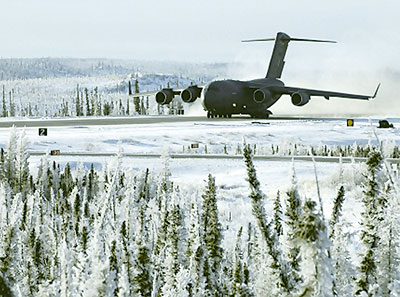 This information has been archived for reference or research purposes.
This information has been archived for reference or research purposes.
Archived Content
Information identified as archived on the Web is for reference, research or recordkeeping purposes. It has not been altered or updated after the date of archiving. Web pages that are archived on the Web are not subject to the Government of Canada Web Standards. As per the Communications Policy of the Government of Canada, you can request alternate formats on the "Contact Us" page.
Aerospace Initiatives
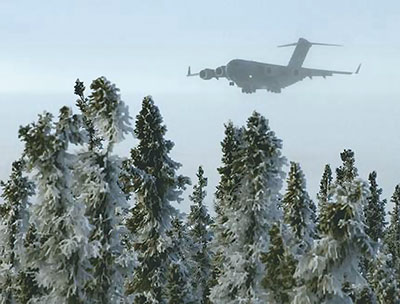
DND photo CK2007-0456-36
A Canadian CC 177 Globemaster III on approach.
What Direction?
The Future of Aerospace Power and the Canadian Air Force – Part 1
For more information on accessing this file, please visit our help page.
The Royal Canadian Air Force, once (at the end of the Second World War) the world’s fourth largest, ... has gradually shrunk to the point where it currently has fewer than 100 fighters, a diminishing fleet of ancient transport aircraft, 40-year-old maritime helicopters, and 18 maritime patrol aircraft greatly in need of updating. Few aircraft in the current inventory can be called reasonably modern.1
Introduction
The Canadian Air Force is at one of those proverbial forks in the road. As part of what Chief of the Defence Staff General Rick Hillier refers to as his transformation agenda, the air force has begun to introduce heavy airlift in the form of the C-17 Globemaster III. In addition, its current air lifter, the CC-130 Hercules, is set to be replaced by the most recent variant of that venerable aircraft. Also under consideration are medium-to-heavy lift helicopters to fill the gap left after the disposal of the CH-147 Chinook in the mid-1990s. All of these capabilities are sorely needed, particularly in light of Canadian Forces ongoing operations in Afghanistan, and any future expeditionary type operations.
However, it also appears that the air force is being asked to sacrifice some of its current and future combat capability to fund these new airlift projects. Most recently, the air force has indicated that it will only be proceeding with upgrades to 10 of the 18 CP-140 Auroras in its maritime patrol aircraft fleet, due in no small measure to an originally-funded $197 million upgrade project that was already $132 million over budget in August 2007. And what the future holds for the CF-18 Hornet fighter aircraft fleet is not yet certain. Nor is it clear what, if any, follow-on fighter or maritime patrol/surveillance aircraft will be purchased to eventually replace the Hornet and Aurora fleets.
Hence, one feels justified in raising some questions regarding the future direction of the Canadian Air Force. The procurement plans in the current program seem to suggest that the air force is on a vector away from a front-line combat capability. Is the air force evolving into a taxi service for the army? Or will it continue to be able to provide a front-line combat capability for Canada in an uncertain future? Clearly, the air force faces a difficult and challenging dilemma. It is indeed time for that service, and also for defence analysts, to consider the future direction for aerospace power in Canada. To that end, this article will seek to accomplish several objectives. First, it will explore the evolution of Canada’s air force from its earliest days. The air force has, throughout its existence, faced the challenge of attempting to stay at or near the leading edge of airpower, and, more recently, aerospace power theory and capability. In so doing, its fortunes have waxed and waned, and it is probably fair to suggest that its fortunes are again waning. The challenge that confronts air force and defence planners in the months and years ahead is to ensure that it is able to arrest the slide toward aerospace irrelevance, and to maintain a modicum of capability in areas critical to both the Canadian Air Force and Canada’s future.
A second objective of this article is to consider future directions for aerospace power in general, for Canada’s air force cannot develop in a vacuum. On one hand, there is a school of thought that holds that future war will be characterized more by small wars requiring counter-insurgency capabilities. On the other, there is a school of thought that takes the view that major interstate war cannot be ruled out, and, hence, technologically advanced capabilities will be required. In all likelihood, the noted American author and military historian Max Boot will be proven correct in his statement that “...the reality is that both high-intensity and low-intensity threats are real and that both top-notch people and first rate equipment are required to counter them.”2 In that case, no air force, Canada’s included, can be concerned only with meeting the immediate requirements of the here and now. Hence, the air force must be concerned that a transformation agenda promising only airlift capability will make it difficult to adapt to the wider range of challenges that may arise in the future.
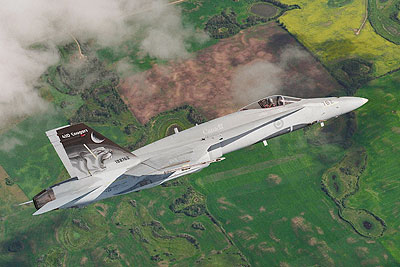
DND photo CKC95-5007
Canada’s CF-18 Hornets, while undergoing major updates and refurbishments, are now a quarter-century old.
Historical Background
Canada’s airpower history is rich and varied. In its various incarnations, Canada’s air services have participated in very nearly the full range of airpower roles that emerged over the first 100 years of powered flight. Today, as the air force appears to be faced with a fundamental challenge to its survival as a front-line combat force, it is appropriate to both reflect back upon the Canadian experience with airpower, and, more importantly, to look forward. What has the air force accomplished? How has it adapted to the rapid evolution of airpower over its brief existence? What are the prospects as the threshold has just been crossed into a second century of airpower? Where will it lead? Will the second century – a century that more appropriately may be termed an aerospace century – be as rich and varied? These are all questions that professional airmen should be contemplating.
Setting the Context
Attempting to provide both a retrospective and a view to the future is a daunting task. For a number of reasons, looking back is not as straightforward as one might first imagine. Canada’s air force has not necessarily been well served by the historical community. As Canadian historians Steve Harris and Brereton Greenhous noted in an article published nearly two decades ago: “...a long-standing difficulty in air history is that most air historians also have been air protagonists, not inclined to tarnish the image the various air forces have so carefully cultivated to strengthen their credibility as independent entities.”3 While Harris and Greenhous were writing mainly about situations pertaining to the Commonwealth air forces during the Second World War, their general point is probably germane to discussions of most air forces across time. And it may be particularly apropos with regard to the Canadian experience.
Most historical treatments have tended to be accounts of operations, squadrons, individuals, and technology. There have been few efforts aimed at synthesizing or integrating the national experience. Aside from the three volumes of the official history of the Royal Canadian Air Force (RCAF) from its origins in the Great War to the end of the Second World War, the story of the RCAF remains largely untold, except in the most fragmented manner. This is, perhaps, one of the greatest gaps in the body of Canadian military history, something that the military history community should set out to rectify.
In some respects, these gaps are reflective of an immature strategic culture. There is little in the body of work that endeavours to look at our past through anything other than historical lenses.4 The past is seen as an artefact, with little to tell us about the present, and even less to say about the future. Desmond Morton’s recent book, Understanding Canadian Defence, is representative of this situation.5 In less than 200 pages, Morton provides a broad, and, by and large, I believe, accurate reading of the higher issues of Canadian defence policy throughout our existence as an independent nation. In effect, Morton sketches out how we reached the point we are at today, but he then figuratively appears to shrug his shoulders and suggest that we are condemned to continue down the same path.
This strategic culture is also reflected in the Canadian military establishment. For easily understandable reasons, Canada’s small, chronically under-funded, under-manned and ill-equipped armed forces have found it difficult to survive. In an atmosphere in which survival is the order of the day, it is not surprising that the professional military establishment seems unable, or unprepared, to look to its past, let alone to its future. As the eminent military historian and commentator Sir Michael Howard once observed: “...there are two great difficulties with which the professional soldier, sailor, or airman has to contend in equipping himself as a commander. First, his profession is almost unique in that he may only have to exercise it once in a lifetime, if indeed that often. Secondly the complex problem of running a [military service] at all is liable to occupy his mind and skill so completely that it is easy to forget what it is being run for.”6 Faced with this situation, it is difficult for armed services to consider long-term future requirements removed from the press of day-to-day matters. Yet, if we are to avoid simply shrugging our shoulders, we need better, for as Howard also wrote:
[The military] is ... like a sailor navigating by dead reckoning. You have left the terra firma of the last war and are extrapolating from the experiences of that war. The greater the distance from the last war, the greater become the chances of error in this extrapolation. Occasionally there is a break in the clouds: a small-scale conflict occurs somewhere and gives you a “fix” by showing whether certain weapons and techniques are effective or not: but it is always a doubtful mix ... For the most part you have to sail on in a fog of peace until at the last moment. Then, probably when it is too late, the clouds lift and there is land immediately ahead; breakers, probably, and rocks. Then you find out rather late in the day whether your calculations have been right or not.7
In keeping with Howard’s analogy, Canada confronts a complex and confounding navigational challenge. Now that the period termed, for want of a better description, the post Cold War era has ended, we stand at the threshold of a new security environment. The contours of this new security environment have only begun to emerge, but it seems probable that this will portend significant implications for Canada’s long-term strategic interests. At root, the challenge is far more complex than finding additional resources, even though additional resources are sorely needed. Canadians also find themselves standing at the threshold of incredible new vistas and possibilities for air and aerospace power. While technological developments and prospects portend many things for air forces, the real challenge involves thinking about the future of airpower, or perhaps more appropriately, aerospace power. What are the capabilities of aerospace power? How will it best be developed and deployed? How might air forces avoid the sterile rhetorical debates about independence that marked the first half-century of military aviation? Will we be condemned to repeat those arguments?
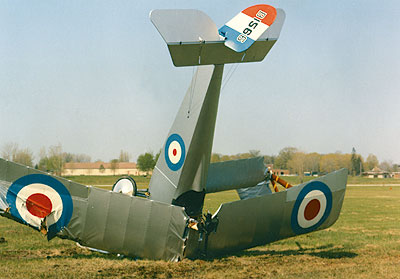
CMJ collection
The earliest combat aircraft were frail indeed, as attested to by the crash of “Billy” Bishop’s replica Nieuport 17 at Abbotsford, British Columbia, in 1989.
A Century of Airpower Experience
Renowned Canadian military historian William A.B. Douglas, in his introduction to the second volume of the official history of the Royal Canadian Air Force, observed: “...[in] the immediate aftermath of the First World War, Canada’s need for an air force was not readily identifiable. The country faced no discernable external threat. Canadians had little appreciation of the potential of airpower and little enthusiasm for expenditures on such esoteric military commitments.”8 How little things have changed. In early 2007, the situation was strikingly similar. And Canada still does not face a discernable external threat from a conventional military power. Canadians have little appreciation of the potential of aerospace power, and they continue to evince little enthusiasm for expenditures on military commitments and military equipment. In light of these realities, the prospects for Canadian aerospace power may appear rather bleak. This is unfortunate, given that aerospace power in general seems poised to offer significant new promise.
Perhaps, however, that has always been the situation for air power and for air forces. As far back as 1917, when General Jan Smuts submitted his report to the British War Cabinet on the future direction for air power in the British armed services, he wrote: “[The] time is rapidly approaching when the subordination of the Air Board and the Air Service could no longer be justified. [The] Air Service... can be used as an independent means of war operations... an air fleet can conduct extensive operations far from, and independently of, both army and navy.”9 Furthermore, in one of the most quoted statements in the early history of air power, Smuts opined: “As far as can at present be foreseen, there is absolutely no limit to its independent war use. And the day may not be far off when aerial operations with their devastation of enemy lands and destruction of industrial and populous centres on a vast scale may become the principal operations of war, to which the older forms of military and naval operations may become secondary and subordinate.”10
Smuts may have been a visionary, or perhaps he was simply enamoured with the promise and prospect that air power might break the deadlock on the ground. In any case, his forecast for the immediate future did not bear fruit. Rather, with respect to airpower, historian David MacIsaac wrote of the situation at the end of the First World War as follows: “Air power as an instrument of warfare was still in its infancy, having played an occasionally spectacular, increasingly important, but nonetheless largely unessential part in the outcome.”11 At the risk of oversimplifying matters, airpower at the end of the Great War was still largely an unknown quantity. Even though virtually every role of airpower that we know today was tried, at least to some extent, during that conflict, MacIsaac’s observation is essentially correct.
If airpower was not “decisive” during the First World War, it did, at the very least, play an increasingly important role as the war progressed. By 1918, plans were well afoot to create a large inter-allied strategic air force to bomb industrial targets as deep as Berlin, and the embryonic RAF had actually fielded an operational unit ready to bomb the German capital when the Armistice intervened. Perhaps more importantly, the airmen who witnessed the incredible carnage of trench warfare desperately sought methods of employing airpower to avoid such warfare in the future. It was the experiences of that war which led many to seek an alternative to the seemingly pointless and brutal slaughter of an entire generation of Europeans. Use of the aircraft appeared to some veterans and observers of the Great War as one of those alternatives. And it was the experiences of air forces from 1914 to 1918 that led to the ‘golden age’ of airpower theory brought forward during the 1920s and 1930s.
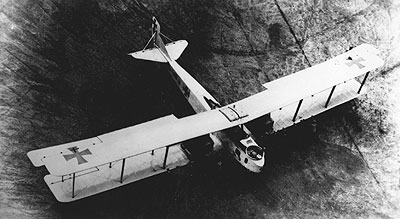
CMJ file photo
One of the first strategic bombers – A German Gotha V of the type used in the wartime attacks upon Britain.
Even though practical experience had been limited, there was no shortage of theorizing about what airpower might be able to accomplish. Generals Douhet, Trenchard, Mitchell, and others missed no opportunity to extol the potential of air forces. In doing so, however, they raised expectations about the power of independent air action to such a level that fears of aerial bombardment in the 1930s were not all that different from the fears that would later surround the prospect of thermo-nuclear war during the Cold War. In effect, Douhet, Trenchard, and, to a lesser extent, Mitchell stoked the fears of aerial bombardment to such an extent that nations such as the United Kingdom, France, and others engaged in a form of self-deterrence. Moreover, arguments about the necessity for air forces to be independent of ground and naval forces led to acrimonious inter-service rivalries, which were compounded by persistent battles over shrinking defence budgets.
In Canada, the years between the wars were marked by more parochial concerns. Debates were animated less by theoretical and doctrinal issues, and more by simple struggles to survive. The 1920s and 1930s, a constant, uphill struggle to maintain even a miniscule air force. At the end of the Great War, the scramble to de-mobilize, repatriate, and disarm was both understandable and necessary. While there was some desultory discussion of maintaining a modest air force, “...the initial interest ... lay in converting the expansive potential of aviation, so clearly demonstrated in war, to constructive peacetime uses, a focus of commitment which coincided nicely with the prejudices of an unmilitary people tired of war and a government bent on economy.”12 At the risk of skating over 20 extremely interesting, extremely innovative, and in the end, extremely productive years with respect to civil aviation, the development of military aviation during those years was limited. By the late 1930s, the Royal Canadian Air Force, which had only gained complete autonomy as a separate service in 1938, was a tiny, ill-equipped, and ill-prepared force, one that was blithely ignorant of the challenges that lay ahead.
The RCAF, while not alone in this respect, was forced to scramble to create a force equal to the tasks that it would confront. Although the Canadian Army and the Royal Canadian Navy were in the same dire circumstances as was the fledgling RCAF, their task was somewhat less daunting. Armies and navies had a wealth of historical experience to draw upon as they raised, trained, and equipped themselves for the Second World War. While there were technological and doctrinal changes – perhaps the most significant being armoured warfare on land, and submarines and aircraft carriers on the oceans, the fundamental principles of land and maritime warfare remained, if not unchanged, at least not vastly different than those that had evolved over the centuries. Air forces, in contrast, had only the briefest experience upon which to draw – at the most, four years during the First World War, and various ‘small wars’ during the two decades between the wars. These experiences, while generally instructive, offered little insight into what lay ahead. The pace of technological change in aviation had been breathtaking. At the outset of the Second World War, the most advanced aircraft were virtually unrecognizable from their antecedents of the Great War. Aircraft had progressed from being wood and fabric biplanes and triplanes, to being all-metal monoplanes. In virtually every respect – speed, rate of climb, payload, manoeuvrability, defensive firepower, and protection – the aircraft of the late 1930s demonstrated vast improvements.
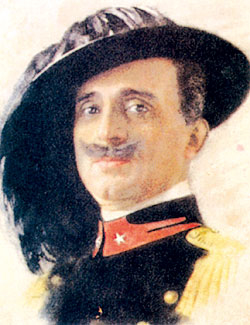
CMJ Collection
One of the best-known prophets of airpower, the Italian General Giulio Douhet.
While aviation technology had progressed rapidly, this was hardly a first order concern for the RCAF at the outbreak of the Second World War. When hostilities broke out in 1939, the RCAF possessed a meagre number of aircraft, an equally meagre number of squadrons, and virtually no doctrinal foundation upon which to build. Although the RCAF had made an impression during the inter-war years with respect to its nation building activities, its professional foundation was hardly extensive. The RCAF would have to learn ‘on the fly,’ as it were. In this, it was not alone. Pre-war expectations with respect to the power of independent strategic bombardment were found to have been vastly overstated. The theories of Douhet and Trenchard were revealed as either optimistic illusions, or simply visions of something that might, at some future time, come to pass.13
During the Second World War, all air forces, the RCAF included, had to grope their way forward through a process of operational trial and error. In doing so, they had some significant successes, as well as some shattering setbacks. Pre-war expectations of the nature of the air warfare proved to be overly optimistic. Ideas with respect to a ‘knockout blow’ to the enemy being delivered by strategic bombardment proved to be hollow. Specifically, notions of vast aerial bombing armadas being able to strike with great accuracy and relative impunity at enemy centres of government and national power were found to be overblown. Indeed, in a curious irony, the air war took on vestiges of the trench warfare of the First World War that airpower was supposed to render unnecessary. During the Combined Bomber Offensive, the forces of the RAF and the USAAF engaged in a persistent and gruelling campaign against the Axis industrial/military complex, a campaign in some ways not unlike the relentless efforts to break through the trench stalemate of the First World War. And the RCAF, in contributing No. 6 Group to Bomber Command, along with the many Canadian airmen who served in other RAF units, played a significant part in this long and costly struggle.
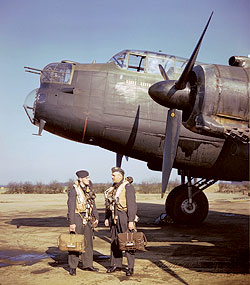
DND photo PC2479
Two stalwarts of #6 (RCAF) Group of wartime Bomber Command in front of a group Avro Lancaster II bomber. Left: Wing Commander Bill Swetman. Right: Air Vice-Marshal Clifford M. “Black Mike” McEwen.
Aside from the strategic air offensive against Germany, the RCAF experience during the Second World War embraced virtually all the other airpower roles – roles that pre-war air power pundits dismissed as auxiliary. In doing so, Canada’s air force became virtually a full-service air force. This was a remarkable achievement, given its starting point. It developed a full range of capabilities, including air superiority, close air support, maritime air patrol, transport, reconnaissance, and a host of other specialized roles. However, much of this experience was obtained outside the national air force. In many cases, these were developed in Canadian squadrons under British command, or from individuals serving with other air forces, principally the RAF. It is worth considering the extent to which this experience with the full range of airpower roles was integrated into a Canadian understanding of air power, either at the time, or subsequently by professional airmen or airpower historians.14 Arguably, it was never fully integrated, and this failure to develop a full appreciation of the broad range of airpower roles has had a baleful influence upon the development of a Canadian context of the air weapon. In short, the strategic culture of the airpower community in Canada was limited.
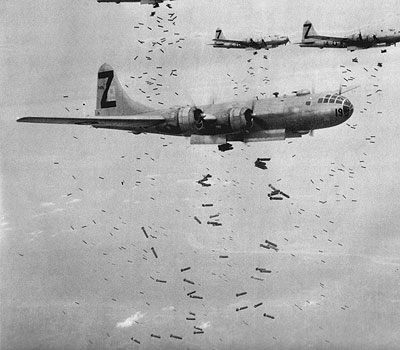
CMJ collection
Boeing B-29 Superfortress bombers, of the type that dropped the atomic bombs on Hiroshima and Nagasaki in August 1945.
That a uniquely Canadian view with respect to the potential of airpower was not readily forthcoming is not, perhaps, very surprising. In the last days of the war against Japan, there was a significant development that cast a long shadow over the evolution of air power – namely, atomic weapons. With the dropping of Fat Man and Little Boy on the cities of Hiroshima and Nagasaki, the apocryphal pre-war theories of Douhet appeared to have been borne out. The United States Army Air Forces, soon to become an independent air service, and soon to be engaged in what would come to be known as the Cold War, viewed atomic weapons as the guarantor of its future independence. In the US air services, the idea crystallized that the strategic bomber, armed with the atomic bomb, would render traditional notions of land and naval warfare both irrelevant and archaic.
In light of this prevailing view, thinking with respect to airpower was channelled down one particular track. While many practitioners have looked back at the rich and varied experiences of airpower in the Second World War, and have remarked upon the numerous roles that airpower had filled, this was largely an academic exercise.15 Additionally, the growing animosity between the Soviet Union and its former Western allies became the central problem for defence planners across the West. Armed with the impression that the Soviet Union possessed vast military resources that could hold a shattered Western Europe at risk, the United States and the United Kingdom cast about for a means to counter this perception. Their answer lay with atomic weapons. For right or for wrong, this conditioned the further development of the aerial weapon for many years.
In Canada, the prevailing Western thinking with respect to the efficacy of atomic weapons, coupled with the inevitable post-war drawdown, again threw the larger defence establishment into disarray. In this instance, however, it was not necessary for both the air force and airpower proponents to argue for the value of airpower. This had been amply demonstrated, perhaps too compellingly, through the atomic drops on Japan. And it buttressed or reinforced the predilections of the airpower pundits that strategic airpower had come of age. In a curious way, this deflected the rivalry from being inter-service to intra-service. Other forms of airpower were relegated to a ‘weak sister’ status. The future of airpower appeared to rest almost exclusively in a strategic offensive role. Other roles that had proved their worth, such as close air support, maritime patrol, air superiority, and countless others, were, for the most part, seen as ancillary – nice to have but perhaps not as necessary as strategic airpower. While Canada and the RCAF did not participate directly in the strategic nuclear game, at least, at the outset, Canadian airmen understood its significance, and, as a matter of course, they sought to contribute to the complex of forces necessary to build the nuclear deterrent posture.16
The Korean War generated a brief resurgence of interest in other roles of airpower. During its course, airpower roles that had been central to the actual fighting during the Second World War re-emerged. Close air support, interception, interdiction, naval aviation, and reconnaissance all proved their worth, even though they had been left to languish as air forces wrestled with the meaning and challenge of the nuclear revolution. This was not a tidy process. Capabilities in virtually all these roles had been downgraded or overlooked. Although the cost of reviving these capabilities was often paid in blood and treasure, it is clear that the Korean War was viewed as an anomaly, something that should not be taken as indicative of the true and correct view of the future of airpower. This particularly held true in the United States Air Force (USAF), but strands of this thinking emerged in air forces across the West.
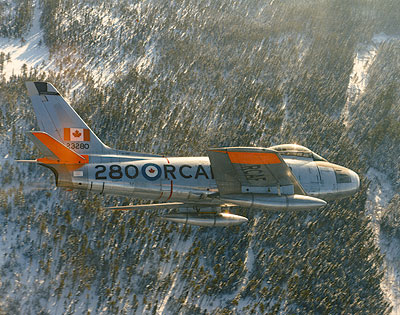
DND photo
Canadair F-86 Sabre Mk.V flying low over a New Brunswick forest during the twilight of its RCAF service.
Because of the perception of the overwhelming threat posed by the Soviet Union, and because of the overwhelming importance of the atomic weapon as a means to counter that threat, the vast majority of thinking about the future of airpower focused almost exclusively upon that aspect. For Canada, two roles became paramount. The first was the creation and deployment of an Air Division to Europe to support NATO. In this forum, for over 40 years, the RCAF – and later the Canadian Air Force – stood the long watch of the Cold War. Even though the roles of these forward deployed forces would evolve and change over that time, the overall principal mandate remained to support NATO’s effort to provide forward defence, a nuclear firebreak, and a nuclear strike capability. The second major focus for the RCAF, and again, later the Canadian Air Force, was the creation of North American Air Defence Command (NORAD – Later North American Aerospace Defence Command – Ed.) as a means to secure North America from a Soviet air attack, and later, to provide early warning of a missile attack. Other roles were seen as being of secondary, or even tertiary, importance.17 Thus, to some extent, Canada’s air forces throughout the Cold War became narrowly focused and narrowly conceived. In this, Canada was not alone. Aside from the USAF, no Western air force was able to deploy the full range of airpower capabilities, and even for the United States Air Force, this proved to be a major challenge.18
While the narrow focus of the RCAF and its successors is at least understandable, in that the threat posed by the Soviet Union and the Warsaw Pact was seen as very real and very dangerous, in the post-Cold War era to date, it is proving somewhat difficult to break out of old thought patterns. In some ways, Canada’s air force in the post-Cold War era, like other air forces, has suffered from a variant of what the respected military analyst with the RAND Corporation, Carl Builder, termed the Icarus Syndrome.19 Builder intimated that the USAF had lost its way, and that rampant and pervasive stove piping was a significant impediment to both individual and institutional development. Although Builder did not profess to have the answer to the problem, he saw part of the corrective as being a sustained and fundamental effort to understand airpower in a holistic fashion, rather than from a role-specific perspective.
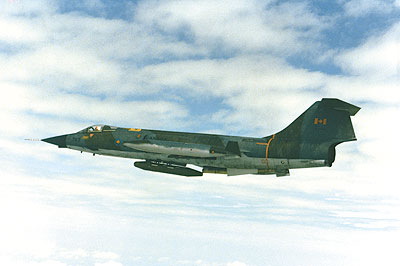
DND photo
A later Canadian Cold War stalwart in German skies – the Canadair CF-104 Starfighter.
In Builder’s view, one of the contributing factors to the USAF’s dilemma in the late 1980s and early 1990s was a predisposition to engage in narrow, technological, platform, and role-specific thinking.20 This resulted in a form of institutional dogma, not unlike that which coloured the debates regarding airpower in the 1920s and 1930s. To avoid the consequences that plagued air forces during those years, Builder proposed that should the USAF – and perhaps by inference other air forces – “...redefine its mission so as to be rationalized with history and future trends, [be] less chauvinistic in its claims and demands, and [be] embracing rather than discriminating among its contributors and practitioners, then the Air Force has a fair chance at creating a vibrant, committed military institution.”21
By the end of the Cold War, or, perhaps more appropriately, by the early-to-mid 1990s, it could be argued that the combination of the Icarus Syndrome, historical drag, budget constraints, and limited strategic thinking and vision confronted Canada’s air forces with a situation not unlike that which they faced throughout the inter-war period. The immediate problem in the 1990s was seen to be one of defending the core capability, however that can be defined. In a perverse way, it was almost a question of how low force levels could be driven. Yet, at the same time as this was going on, the debate over the vast new prospects of airpower was moving inexorably forward. The Gulf War of 1991 held out new promises for airpower. Allowing for the extreme rhetorical flourishes on the part of some airpower proponents, it was clear that airpower did indeed stand at the threshold of new vistas and new possibilities.
Editor’s Note – Doctor Robertson will conclude this article in the Spring 2008 edition.
![]()
Doctor Scot Robertson is an Associate Professor in the Department of History and Classics at the University of Alberta, where he teaches military history. Prior to this, he taught at the Royal Military College, and was a defence scientist and strategic analyst with the Department of National Defence.
Notes
- General (ret’d) Paul Manson, “Air Force Acquisition” in Richard Gimblett, (ed.) Creating an Acquisition Model That Delivers, (Ottawa, CDAI, April 2006.) p. 40. When General Manson wrote this paper, decisions with respect to the acquisition of the CC177 Globemaster III had not been finalized.
- Max Boot, War Made New, (New York: Gotham Books, 2006.) p. 471.
- Stephen Harris and Brereton Greenhous, “British and Commonwealth Air Forces,” in Aerospace Historian, Vol. 31, No. 1, 1984. p. 51.
- There are some notable exceptions to this dismal situation. John English for one, in his Failure in High Command: The Canadian Army and the Normandy Campaign (Ottawa: Golden Dog Press, 1995), has attempted to provide not only an historical accounting of a particular episode in Canada’s military history, but also to draw from this larger issues – lessons if you will. While not everyone agrees with English’s interpretations, the study of Canadian military history is better for his efforts.
- Desmond Morton, Understanding Canadian Defence (Toronto: Penguin Books, 2003).
- Sir Michael Howard, “The Use and Abuse of Military History,” in Journal of the Royal United Services Institute, Vol. 107, February 1962, p. 6.
- Sir Michael Howard, “Military Science in an Age of Peace,” in Journal of the Royal United Services Institute, No. 119, March 1974, p. 4.
- W.A.B. Douglas, The Creation of a National Air Force: The Official History of the Royal Canadian Air Force, Volume II, (Toronto: University of Toronto Press, 1986), p. 36.
- Public Record Office, Air 8/2, Committee on Air Organisation and Home Defence Against Air Raids, 17 August 1917.
- PRO, Air 8/2, Committee on Air Organisation and Home Defence Against Air Raids, 17 August 1917.
- David MacIsaac, “Voices from the Central Blue,” in Peter Paret (ed.) Makers of Modern Strategy, (Oxford: Oxford University Press, 1986), p. 629.
- Douglas, p. 36.
- For an interesting discussion of the nature of theories of air power see I.B. Holley, “Reflections on the Search for Airpower Theory,” in Phillip Meilinger (ed.), The Paths of Heaven: The Evolution of Airpower Theory (Maxwell AL: Air University Press, 1997), pp. 579-599.
- Unfortunately, the fourth volume of the official history of the RCAF fell victim to the defence cuts of the early 1990s, and this vital question remains unexplored. Arguably, the RCAF has been badly served by historians. For the most part, historical treatments have tended to focus upon aircraft, technology, squadron histories, individual memoirs, and the like. Major efforts at synthesizing Canada’s overall airpower experience are lacking. Unless efforts are made to redress this situation, the nation runs the risk of losing part of its heritage, and, perhaps more alarmingly, it runs the risk of repeating the experience of the 1930s, with all the consequences that were embodied in the Second World War experience.
- One need only examine the efforts to assess the effectiveness of the strategic bombing campaign during the Second World War. Both the United States Strategic Bombing Survey (USSBS) and the British Bombing Survey Unit (BBSU) have been seen by some historians as efforts to cast strategic bombing in a favourable light. Thomas Hughes, in a paper presented at the Royal Military College of Canada 25th Military History Symposium, has provided an insightful and incisive analysis of the machinations surrounding creation and work of the USSBS. (Hughes, “Remembering War: The United States Air Force, 1945-1950,” unpublished paper presented at the 25th RMC Military History Symposium, 21 March 2003). Similar controversy surrounds the work of the BBSU, which remained classified for years after the Second World War. For an analysis of the BBSU see Sebastian Cox (ed.), The Strategic Air War Against Germany, 1939-1945: The Official Report of the British Bombing Survey Unit (London: Frank Cass, 1998). There has been lively debate over the effectiveness of the strategic bomber offensive, a debate that continues today. See, for example Richard Overy, Why The Allies Won (New York: Norton, 1995). Overy and others argue, correctly I believe, that the Combined Bomber Offensive forced the Germans to deflect considerable resources towards efforts to mount an air defence of the homeland, and that this contributed to the invasion of the European continent by Allied land forces, and, ultimately, to the invasion of the German homeland.
- The story of the RCAF in the early post-Second World War years remains largely untold, or, at the very least, poorly told. Although there are numerous discussions of higher defence policy planning, the particular problems of force development, force structure, and doctrinal development have been largely ignored. This is a field that is rich with possibilities for enterprising historians and graduate students seeking to explore an important aspect of Canada’s military history. More importantly, opportunities abound to contribute to the development of a wider appreciation of Canada’s role in the Cold War, and to an understanding of a larger Canadian strategic culture.
- This is not intended to ignore the development of airborne anti-submarine warfare (ASW), tactical airpower in support of land forces, rotary wing aviation, and other airpower roles. These roles, and the capabilities necessary to execute them, were worked out in cooperation with naval and land forces. However, it is probably fair to say that they were worked out in response to requests or pressure from armies and navies, rather than from air force initiatives.
- Canada’s Cold War history remains virtually a blank slate. While there have been some recent entries onto the field – Sean Maloney, and Andrew Richter stand out – there remains much to be done. A cursory perusal of history departments across the country, however, gives little indication that Cold War history is much of an interest or priority. To some extent, this is not surprising, given the paucity of interest in military history generally.
- Carl Builder, The Icarus Syndrome: The Role of Air Power Theory in the Evolution and Fate of the US Air Force (New Brunswick, NJ: Transaction Publishers, 1996).
- Ibid., pp 281-291.
- Ibid., p. 282.
